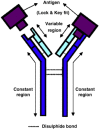Recent Advances in Biosensor Development for Foodborne Virus Detection
- PMID: 29071193
- PMCID: PMC5646734
- DOI: 10.7150/ntno.20301
Recent Advances in Biosensor Development for Foodborne Virus Detection
Abstract
Outbreaks of foodborne diseases related to fresh produce have been increasing in North America and Europe. Viral foodborne pathogens are poorly understood, suffering from insufficient awareness and surveillance due to the limits on knowledge, availability, and costs of related technologies and devices. Current foodborne viruses are emphasized and newly emerging foodborne viruses are beginning to attract interest. To face current challenges regarding foodborne pathogens, a point-of-care (POC) concept has been introduced to food testing technology and device. POC device development involves technologies such as microfluidics, nanomaterials, biosensors and other advanced techniques. These advanced technologies, together with the challenges in developing foodborne virus detection assays and devices, are described and analysed in this critical review. Advanced technologies provide a path forward for foodborne virus detection, but more research and development will be needed to provide the level of manufacturing capacity required.
Keywords: Foodborne virus; biosensor; microfluidics; nanomaterials; point-of-care..
Conflict of interest statement
Competing Interests: The authors have declared that no competing interest exists.
Figures








Similar articles
-
Recent Advances in Biosensor Development for the Detection of Viral Particles in Foods: A Comprehensive Review.J Agric Food Chem. 2023 Nov 1;71(43):15942-15953. doi: 10.1021/acs.jafc.3c05166. Epub 2023 Oct 20. J Agric Food Chem. 2023. PMID: 37862248 Review.
-
Advances, applications, and limitations of portable and rapid detection technologies for routinely encountered foodborne pathogens.Front Microbiol. 2022 Dec 5;13:1054782. doi: 10.3389/fmicb.2022.1054782. eCollection 2022. Front Microbiol. 2022. PMID: 36545205 Free PMC article. Review.
-
Recent advancements in microfluidic chip biosensor detection of foodborne pathogenic bacteria: a review.Anal Bioanal Chem. 2022 Apr;414(9):2883-2902. doi: 10.1007/s00216-021-03872-w. Epub 2022 Jan 21. Anal Bioanal Chem. 2022. PMID: 35064302 Free PMC article. Review.
-
Advanced diagnostic methods for identification of bacterial foodborne pathogens: contemporary and upcoming challenges.Crit Rev Biotechnol. 2023 Dec;43(7):982-1000. doi: 10.1080/07388551.2022.2095253. Epub 2022 Aug 22. Crit Rev Biotechnol. 2023. PMID: 35994308 Review.
-
Microfluidic devices for sample preparation and rapid detection of foodborne pathogens.Biotechnol Adv. 2018 Jul-Aug;36(4):1003-1024. doi: 10.1016/j.biotechadv.2018.03.002. Epub 2018 Mar 10. Biotechnol Adv. 2018. PMID: 29534915 Review.
Cited by
-
Common and Potential Emerging Foodborne Viruses: A Comprehensive Review.Life (Basel). 2024 Jan 28;14(2):190. doi: 10.3390/life14020190. Life (Basel). 2024. PMID: 38398699 Free PMC article. Review.
-
Mitigating Global Challenges: Harnessing Green Synthesized Nanomaterials for Sustainable Crop Production Systems.Glob Chall. 2023 Dec 25;8(1):2300187. doi: 10.1002/gch2.202300187. eCollection 2024 Jan. Glob Chall. 2023. PMID: 38223890 Free PMC article. Review.
-
A review of current effective COVID-19 testing methods and quality control.Arch Microbiol. 2023 May 17;205(6):239. doi: 10.1007/s00203-023-03579-9. Arch Microbiol. 2023. PMID: 37195393 Free PMC article. Review.
-
Insight of smart biosensors for COVID-19: A review.Luminescence. 2023 Jul;38(7):1102-1110. doi: 10.1002/bio.4430. Epub 2023 Jan 23. Luminescence. 2023. PMID: 36577837 Free PMC article. Review.
-
Positively Charged Gold Quantum Dots: An Nanozymatic "Off-On" Sensor for Thiocyanate Detection.Foods. 2022 Apr 19;11(9):1189. doi: 10.3390/foods11091189. Foods. 2022. PMID: 35563912 Free PMC article.
References
-
- Callejón RM, Rodríguez-Naranjo MI, Ubeda C. et al. Reported foodborne outbreaks due to fresh produce in the United States and European Union: trends and causes. Foodborne Pathog. Dis. 2015;12(1):32–38. - PubMed
-
- Kozak GK, MacDonald D, Landry L. et al. Foodborne outbreaks in Canada linked to produce: 2001 through 2009. J. Food Prot. 2013;76(1):173–183. - PubMed
-
- LeDuc P, Agaba M, Cheng CM. et al. Beyond disease, how biomedical engineering can improve global health. Sci Transl Med. 2014;6(266):266fs48. - PubMed
Publication types
LinkOut - more resources
Full Text Sources
Other Literature Sources

